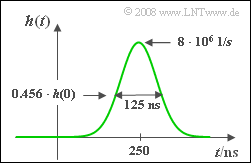Exercise 1.7: Nearly Causal Gaussian Low-Pass Filter
Measurements have shown that an LTI–system can be well approximated by a Gaussian low-pass filter if an additional runtime $τ$ is taken into account. Thus, the frequency response is:
- $$H(f) = {\rm e}^{-\pi\hspace{0.05cm}\cdot \hspace{0.05cm}(f/\Delta f)^2} \cdot {\rm e}^{-{\rm j}\hspace{0.05cm}\cdot \hspace{0.05cm}2\pi f \tau}.$$
The two system parameters,
- the equivalent duration of the impulse $Δt = 1/Δf$ and
- the delay time $τ$,
can be taken from the impulse response $h(t)$ shown in the graph.
- It is obvious that this model does not correspond exactly to the (causal) reality since the impulse response $h(t)$ does not completely vanish even for $t < 0$ .
- Therefore, in subtask (3) the maximum relative error is aked for and defined as follows:
- $$\varepsilon_{\rm max} = \frac{\max_{t \hspace{0.02cm}< \hspace{0.1cm}0}|h(t)|}{h(t = \tau)}.$$
In words: The maximum relative error $ε_{\rm max}$ is equal to the maximum value of the impulse response $h(t)$ at negative times with respect to the maximum value $h(t = τ)$ of the impulse response.
Please note:
- The exercise belongs to the chapter Some Low-Pass Functions in Systems Theory.
- In particular, reference is made to the page Gaussian low-pass filter.
- You can use the Gaussian (error) integral to calculate step and rectangle responses:
- $${\rm \phi}(x) = \frac{1}{\sqrt{2 \pi }} \cdot \int_{ -\infty }^{ x } {{\rm e}^{-u^2/2}} \hspace{0.1cm}{\rm d}u.$$
Questions
Solution
- This is also the reciprocal of the equivalent impulse duration $Δt = 125 \ \rm ns$.
- The phase runtime $τ \hspace{0.15cm} \rm \underline{= \ 250 \ \rm ns}$ can be read directly from the graph, too.
(2) Without consideration of the runtime the result would be a cosine signal with the amplitude
- $$A_y = 1\,{\rm V} \cdot {\rm e}^{-\pi({ {6\,\rm MHz} }/{ {8\,\rm MHz} })^2}= 0.171\,{\rm V}.$$
- The runtime causes a phase shift of $3π$:
- $$ y(t) = A_y \cdot {\rm cos}(2\pi f_0 ( t - \tau) ) = A_y \cdot {\rm cos}(2\pi f_0 t - 2\pi \cdot {6\,\rm MHz}\cdot {250\,\rm ns} ) = A_y \cdot {\rm cos}(2\pi f_0 t - 3\pi ) = -A_y \cdot {\rm cos}(2\pi f_0 t ).$$
- Hence, the searched-for value is $y(t = 0) \hspace{0.05cm} \rm \underline{= \ –0.171 \ V}$.
(3) The impulse response is:
- $$h(t) = h_{\rm GTP}(t - \tau) =\Delta f \cdot {\rm e}^{-\pi(\frac{t - \tau}{\Delta t})^2} .$$
- Since $h(t)$ increases steadily in the range $t < 0$ the maximum value (at negative times) occurs approximately at $t = 0$ :
- $$h(t = 0) = \Delta f \cdot {\rm e}^{-\pi(\frac{ \tau}{\Delta t})^2}= \Delta f \cdot {\rm e}^{-4\pi} .$$
- Using $h(t = τ) = Δf$ the following is obtained:
- $$\varepsilon_{\rm max}= {\rm e}^{-4\pi}\hspace{0.15cm}\underline{ \approx 3.49} \cdot 10^{-6} .$$
(4) For the moment, we leave the phase runtime $τ$ of the second system out of consideration and compute the step response of the Gaussian low-pass filter:
- $$\sigma_{\rm GTP}(t) = \frac{1}{\Delta t} \cdot \int_{ -\infty }^{ t } {{\rm e}^{-\pi \left({t\hspace{0.05cm}'}/{\Delta t}\right)^2}} \hspace{0.1cm}{\rm d}t'.$$
- After the substitution $u = t\hspace{0.05cm}' \cdot {\sqrt{2\pi}}/{\Delta t}$ the following arises as a result with the Gaussian (error) integral $ϕ(x)$:
- $$\sigma_{\rm GTP}(t) = \frac{1}{\sqrt{2 \pi } } \cdot \int_{ -\infty }^{ \sqrt{2\pi}\cdot\hspace{0.05cm} t / \Delta t } { {\rm e}^{-u^2/2} } \hspace{0.1cm}{\rm d}u = {\rm \phi}(\sqrt{2\pi}\cdot \frac{t}{\Delta t }),\hspace{1cm} {\rm \phi}(x) = \frac{1}{\sqrt{2 \pi }} \cdot \int_{ -\infty }^{ x } {{\rm e}^{-u^2/2}} \hspace{0.1cm}{\rm d}u.$$
- Taking into account the runtime $τ$ one thus obtains for the total step response:
- $$\sigma(t) = \sigma_{\rm GTP}(t - \tau) = {\rm \phi}(\sqrt{2\pi}\cdot \frac{t - \tau}{\Delta t }).$$
- The value at $t = τ = 250 \ \rm ns$ is
- $$\sigma(t = {250\,\rm ns}) = \sigma_{\rm GTP}(t = 0) =\ \rm \underline{ϕ(0) \ = \ 0.500}.$$
- Accordingly, for $t = τ = 300 \ \rm ns$ the following is obtained:
- $$\sigma(t = {300\,\rm ns}) = \sigma_{\rm GTP}(t = {50\,\rm ns}) = {\rm \phi}(\sqrt{2\pi}\cdot \frac{ {50\,\rm ns} }{ {125\,\rm ns} })\approx {\rm \phi}(1)\hspace{0.15cm}\underline{ = 0.841}.$$

